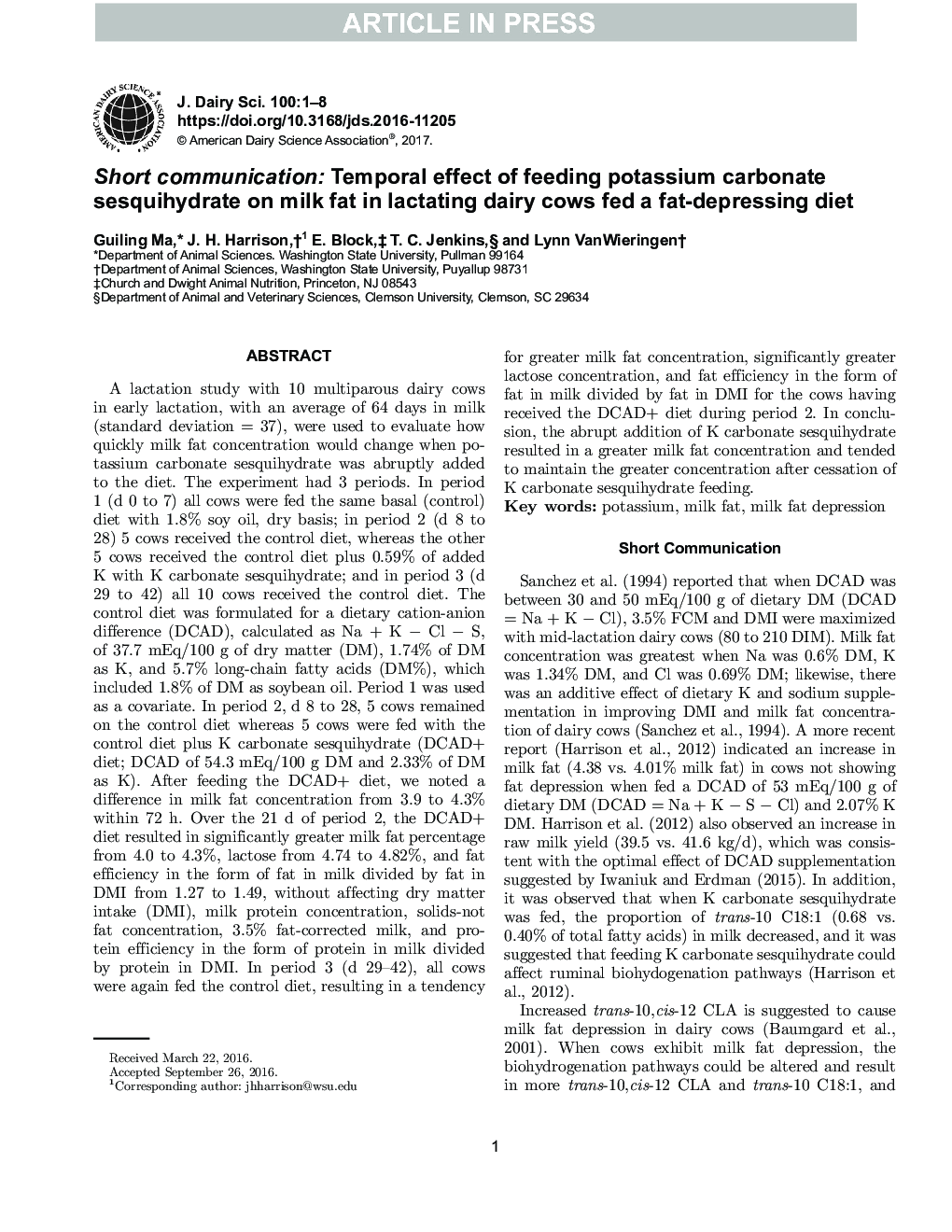| کد مقاله | کد نشریه | سال انتشار | مقاله انگلیسی | نسخه تمام متن |
|---|---|---|---|---|
| 5542576 | 1402520 | 2017 | 8 صفحه PDF | دانلود رایگان |
عنوان انگلیسی مقاله ISI
Short communication: Temporal effect of feeding potassium carbonate sesquihydrate on milk fat in lactating dairy cows fed a fat-depressing diet
ترجمه فارسی عنوان
ارتباط کوتاه: اثر موقتی خوردن هیدرات کربنات پتاسیم بر چربی شیر در گاوهای شیرده تغذیه شده با رژیم غذایی کم چربی
دانلود مقاله + سفارش ترجمه
دانلود مقاله ISI انگلیسی
رایگان برای ایرانیان
کلمات کلیدی
پتاسیم، چربی شیر افسردگی چربی شیر،
موضوعات مرتبط
علوم زیستی و بیوفناوری
علوم کشاورزی و بیولوژیک
علوم دامی و جانورشناسی
چکیده انگلیسی
A lactation study with 10 multiparous dairy cows in early lactation, with an average of 64 days in milk (standard deviation = 37), were used to evaluate how quickly milk fat concentration would change when potassium carbonate sesquihydrate was abruptly added to the diet. The experiment had 3 periods. In period 1 (d 0 to 7) all cows were fed the same basal (control) diet with 1.8% soy oil, dry basis; in period 2 (d 8 to 28) 5 cows received the control diet, whereas the other 5 cows received the control diet plus 0.59% of added K with K carbonate sesquihydrate; and in period 3 (d 29 to 42) all 10 cows received the control diet. The control diet was formulated for a dietary cation-anion difference (DCAD), calculated as Na + K â Cl â S, of 37.7 mEq/100 g of dry matter (DM), 1.74% of DM as K, and 5.7% long-chain fatty acids (DM%), which included 1.8% of DM as soybean oil. Period 1 was used as a covariate. In period 2, d 8 to 28, 5 cows remained on the control diet whereas 5 cows were fed with the control diet plus K carbonate sesquihydrate (DCAD+ diet; DCAD of 54.3 mEq/100 g DM and 2.33% of DM as K). After feeding the DCAD+ diet, we noted a difference in milk fat concentration from 3.9 to 4.3% within 72 h. Over the 21 d of period 2, the DCAD+ diet resulted in significantly greater milk fat percentage from 4.0 to 4.3%, lactose from 4.74 to 4.82%, and fat efficiency in the form of fat in milk divided by fat in DMI from 1.27 to 1.49, without affecting dry matter intake (DMI), milk protein concentration, solids-not fat concentration, 3.5% fat-corrected milk, and protein efficiency in the form of protein in milk divided by protein in DMI. In period 3 (d 29-42), all cows were again fed the control diet, resulting in a tendency for greater milk fat concentration, significantly greater lactose concentration, and fat efficiency in the form of fat in milk divided by fat in DMI for the cows having received the DCAD+ diet during period 2. In conclusion, the abrupt addition of K carbonate sesquihydrate resulted in a greater milk fat concentration and tended to maintain the greater concentration after cessation of K carbonate sesquihydrate feeding.
ناشر
Database: Elsevier - ScienceDirect (ساینس دایرکت)
Journal: Journal of Dairy Science - Volume 100, Issue 1, January 2017, Pages 371-378
Journal: Journal of Dairy Science - Volume 100, Issue 1, January 2017, Pages 371-378
نویسندگان
Guiling Ma, J.H. Harrison, E. Block, T.C. Jenkins, Lynn VanWieringen,
